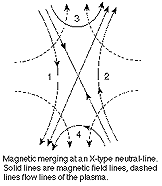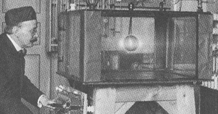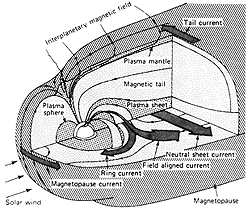|
Wedged between the two bundles--the two "tail lobes"--was the tail's plasma sheet, a layer of hot plasma which turned out to be the main source of auroral electrons. The magnetic field of the plasma sheet is weak, with hairpin-shaped magnetic field lines, and that turned it into a somewhat unstable region, the origin of many of the magnetic disturbances observed in space and on the ground. The reason auroras are rare near the magnetic poles, but occur fairly regularly along large rings surrounding each pole, is that auroral electrons (and their associated electric currents) are guided along magnetic field lines. Magnetic field lines from the "auroral oval" lead back to the plasma sheet, whereas those from the magnetic poles themselves (and the regions near them) end up in the twin bundles of the tail lobes, which contain rather little plasma.
Birkeland's observations were also validated, again with some modifications. What he called polar magnetic storms are now known as magnetic substorms, so named by Chapman who at first viewed them as component parts of magnetic storms--before it was realized that they occurred at other times as well. They represent violent changes in the plasma sheet which energize its ions and electrons, hurl them earthward, and in that way contribute to the outer ring current. Magnetic storms, following the arrival of a fast cloud, create very powerful disturbances of this kind and seem to be the main agent replenishing the ring current, though the details still need to be worked out.
The electric current system, which Birkeland claimed accompanied the aurora, was also observed, though its structure was somewhat different from what Birkeland had proposed. It forms an intricate pattern first traced by Alfred Zmuda and James Armstrong, using a "piggyback" (free ride) magnetometer aboard the Navy satellite Triad. Milo Schield, Alex Dessler and John Freemen, who theoretically predicted such currents in 1969, named them "Birkeland currents" and the name is still used. Birkeland currents provide the energy for most auroral arcs, but auroral electrons are then energized only close to Earth, getting their main push in the lowest 1-1.5 RE of their guiding field lines.
18. Magnetic Reconnection
 |
| Fig 15. Dungey's view of plasma flow and magnetic field lines at an X-type neutral point.
|
In such a brief description it is hard to do justice to the extensive field of magnetospheric physics. Like most physical processes, those of the magnetosphere, too, must usually be paid for in energy, the universal currency of physics. Except for the inner belt, the source of that energy seems to be the solar wind. If the separation between interplanetary and terrestrial field lines were strictly enforced, it would be rather difficult to transmit energy from one region to the other, but there exists a loophole. Magnetic field lines can change their linkage and "reconnect" in new ways, if the plasma in which they are embedded flows through an "x-type neutral point" (or "neutral line") at which the field intensity drops to zero and field lines cross in the pattern of the letter x (Figure 15).
James Dungey in England proposed [Dungey, 1961; Stern, 1986] that two such points were formed on the magnetopause, the boundary of the magnetosphere. One occured on the sunward side, where interplanetary magnetic field lines and terrestrial lines formed an x-shaped neutral point (or a continuous line of such points), at which they split up and reconnected. If the interplanetary field points exactly south, the plasma flows along the thick arrows in Figure 15--the solar wind plasma arriving from the left and the magnetospheric plasma coming from the right. The northern half of the terrestrial line then connects to the northern half of the interplanetary line, a similar process joins the southern halves, and the plasmas attached to the newly reconnected lines then flow outwards--up or down, in Figure 15.
This, Dungey assumed, created "open" field lines, starting in the polar regions of Earth and extending to interplanetary space, and along such lines, energy and plasma easily flowed from the solar wind to the magnetosphere. The process ended (in Dungey's original theory) at a second neutral point in the distant tail, where reconnection re-united the two terrestrial halves and the two interplanetary halves, after which the two plasmas were again separated.
If the interplanetary field lines pointed not southwards but just slanted towards the south, reconnection is a bit more complicated, introducing a bend in each "open" field line, at which the direction of the terrestrial line gradually changes over to that of the interplanetary one. If the field line slants northwards, the bending is more severe--the northern half of the terrestrial field line must link up with the interplanetary half which comes from the south, and vice versa. If the northward slant is steep, reconnection is expected to become increasingly difficult--the interplanetary field lines just have the "wrong direction" for linking up.
The actual process is probably much more complicated, but one of its predictions was amply confirmed. It was found [Fairfield and Cahill, 1966] that the most important factor promoting magnetic substorms, large Birkeland currents and other active phenomena was the slant of the interplanetary magnetic field. With southward slant activity was likely, with northward slant it was inhibited, and other factors--such as the velocity and density of the solar wind--were much less important.
Magnetic reconnection may also occur in the plasma sheet, constituting there an important element of the substorm process, but details will have to wait for more thorough studies of the magnetosphere, using simultaneous data from a much larger number of satellites than is available now.
Reconnection, acceleration and energization of plasma in the magnetosphere all involve a complicated interplay between magnetic and electric fields. Static magnetic fields can trap and steer electrons and ions without changing their energy. Since the fields do not have to supply energy, they can maintain the trapping indefinitely without requiring any additional energy input.
On the other hand, an electric field, a region of electric forces, is not only able to energize particles, it can also help them move from one field line to another, e.g. enter regions of magnetic trapping or escape from them. Electric fields therefore have a central role, both in bringing fresh particles into the ring current, as happens during magnetic storms, and in adding energy to those particles.
In addition, electric forces parallel to magnetic field lines are also instrumental in accelerating (negative) auroral electrons downward. By its nature, any "parallel electric field" which does so, will also grab positive oxygen ions from the ionosphere and accelerate them upwards, towards the magnetic equator, where many join the ring current; such "ion beams" were discovered in 1977 by the USAF satellite S3-3. Furthermore, electric fields are also essential to the energy exchange in substorms and to reconnection. The details of such processes (to the extent they are understood) are, however, completely beyond the scope of this brief and non-mathematical overview.
|




